Quokka Quokka Facts
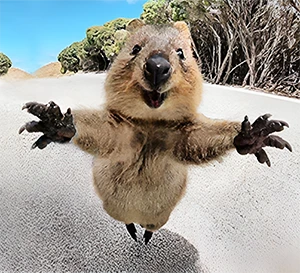
Photo: A smiling quokka
Welcome to the fascinating world of the quokka, a delightful Australian marsupial renowned for its infectious smile and friendly personality, which has earned it the reputation of being the happiest animal in the world. This small, hopping marsupial resembles a cuddly blend of a teddy bear and a cat, with grey-brown fur and an adorable round face adorned with teddy-bear-like eyes and ears. However, despite its charming appeal, the quokka is endangered, with a dwindling population of approximately 10,000 residing primarily on Rottnest Island in Western Australia.
Quokka SelfieHow to Take a Perfect Selfie with A Quokka
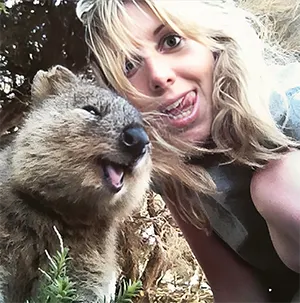
Photo: Quokka selfie
Capturing the perfect selfie with a quokka requires a delicate balance of respect for the animal and strategic positioning for the best photo opportunity. Capturing the perfect selfie with a quokka requires a delicate balance of respect for the animal and strategic positioning for the best photo opportunity. Remember, the quokka is a naturally curious and friendly animal, so wait for it to approach you willingly. Never force it into a photo opportunity. Once the quokka is comfortable, squat down to its level to create an intimate connection. Be patient and seize the moment when the quokka flashes its signature grin. Encourage the quokka to look towards the camera by making soft sounds.
Remember, the key to a perfect quokka selfie is mutual respect and admiration for these adorable creatures. Always maintain a safe distance and avoid touching or feeding the quokka, as touching, feeding, endangering, or interfering with quokkas is illegal and can result in huge fines of up to $50,000.
Even though quokkas appear friendly and happy for selfies, they may still bite or scratch, so taking precautions while photographing them is essential. Following these simple guidelines, you can get your selfie while protecting this vulnerable species from extinction.
How to Pronounce Quokka How Did the Quokka Get its Name?
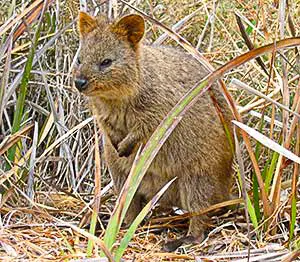
Photo: Quokka in its natural habitat
'Quokka' is pronounced in several different ways. Some pronounce it kwo-ka (rhymes with "mocha"). But most people say kwah-ka (rhymes with "wokka").
The quokka got its name from the local Aboriginals who referred to these as ‘quak –a’ and ‘kwoka’. So Europeans started calling this animal a ‘quokka’. The quokka is also known as the short-tailed scrub wallaby. Its scientific name is Setonix brachyurus.
Quokka Habitat Where Do Quokkas Live?
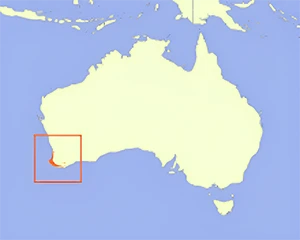
Photo: Quokka Habitat Map
Quokkas live in moist, dense scrubland on Rottnest Island and Bald Island off the coast of Western Australia (see map). A tiny population of quokkas is also found on the Australian mainland in south-western Western Australia in vegetation around swamps and near watercourses. Despite their adaptability, habitat loss due to human encroachment poses a significant threat to quokka populations, emphasizing the importance of conservation efforts to preserve their natural environments.
Quokka Diet What Do Quokkas Eat?
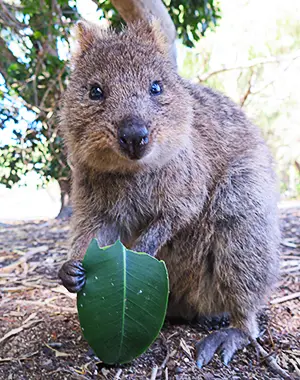
Photo: Quokka eating a leaf
Quokkas are browsing herbivores. They eat leaves and soft shoots of woody plants and supplement their diet with water-retaining succulents. However, on Rottnest Island, they have adapted to eating succulents and grasses instead. Quokkas eat by biting off a piece of vegetation, stuffing it into their mouths, chopping it into small pieces, and swallowing it. They later regurgitate their food and chew it thoroughly before swallowing it again. (Similar to cattle chewing the cud). Quokkas may climb a tree to reach their meal when food is not readily available at ground level. Quokkas get most of the water they require from their food. It is only in arid conditions that they need to drink water. Like most macropods, quokkas store fat in their tails for hard times when food is scarce.
Quokka Behaviour & Social Structure More Details About the Quokka
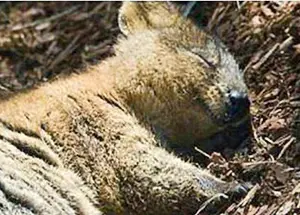
Photo: Quokka resting
Quokkas live in family groups varying in size from 20 to 150 individuals. Dominated by a male, these groups aren't territorial and have overlapping home ranges. While peaceful animals, fights sometimes occur between males, usually for a choice resting place under a shady tree. Quokkas spend most of the day napping in the shade in dense vegetation.
Quokkas are nocturnal animals that are mainly active during dawn and dusk - which can continue into the night. During these times, quokkas venture out of their daytime shelters and travel along well-worn paths and tunnels they have forged through grass and shrubs in search of food. On Rottnest Island, however, it is not uncommon to see quokkas moving about during the daytime. This is an adoption by them to be fed by humans.
Quokka Reproduction Quokka Baby (Joey)
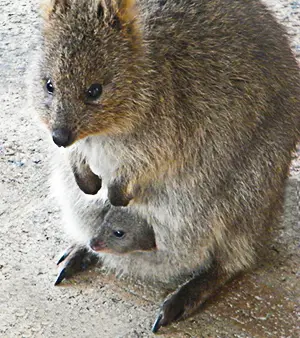
Photo: A female quokka with its joey
Female quokkas become sexually active at 18 months and usually give birth to one baby at a time. The gestation period for a baby quokka consists of two stages. The first lasts about 30 days within the mother’s body, followed by another 6 months in her external pouch, called the marsupium. This type of gestation differs from placental mammals, such as humans, where the baby spends its gestation time entirely inside their mother’s body.
Stage 1 – The typical gestation period for a quokka baby is 21-30 days. When it’s born, the little joey measures just about 1cm in length and weighs less than 0.4 grams! It is born blind and hairless, with short forelimbs and undeveloped hind legs and tail. The newborn joey travels on its own to its mother’s pouch, crawling up her fur in a swimming (breaststroke) motion, which takes around three minutes. The mother does not help the baby during this journey in any way.
Stage 2 – Once inside its mother's pouch, the baby quickly attaches itself to one of four nipples in her pouch. There the young joey will stay hidden for up to six months. Then it will start to tentatively pop its head out of its mother's pouch and observe the world around it. About two weeks later, it will have gained enough confidence to venture out of the pouch and hop close to its mother. However, if frightened, it will immediately jump, head first, back into the safety of the pouch. When it is about 8 months old, the joey no longer uses its mother's pouch. However, it may still suckle from its mother for another 6 months.
Quokkas Throwing Baby Do Quokkas Toss Their Babies Away?
Can quokkas actually throw their babies at predators? The answer is no. Their arms are too short and not strong enough to do this. However, female quokkas may still use a clever biological strategy to escape a dangerous situation. If a predator threatens her, the mother may eject her offspring from her pouch. The abandoned baby draws the predator to the youngster on the ground, allowing the mother to escape. This ensures her survival, although it does mean sacrificing her young.
Quokka Attack! Attack of the Quokka
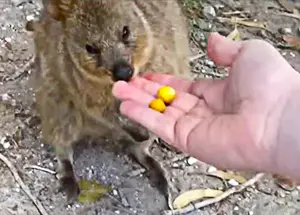
Photo: Don't feed the quokka. They may bite.
Quokkas have a timid and gentle nature. However, they can take drastic measures to defend themselves if provoked or attacked. For example, Quokkas initially try to hop away or shriek loudly when disturbed. But if this fails, it may resort to its last line of defence, known as the Quokka Attack. This involves sinking its teeth into a fleshy part of its attacker's body and then swinging from them while violently scratching with its claws.
Human Cruelty to Quokkas Humans Harming Quokkas
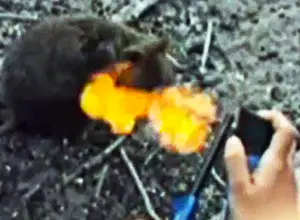
Photo: A man setting fire to a quokka
Quokkas are sometimes the target of mistreatment and cruelty by humans. In April 2015, two French tourists ignited an aerosol mister that burned a quokka's fur. The perpetrators were fined $4,000 and imprisoned for their actions. In February 2017, a man was videoed kicking a quokka multiple times; he too was fined $4,000. In yet another case, a New Zealand man threw a quokka into the sea. Luckily the distressed animal swam ashore safely. The man claimed in court that he merely "placed" the quokka in the water and didn't actually throw it in. The judge fined him $2,000. The maximum penalty for animal cruelty is a $50,000 fine and five years in jail.
Quokka Predators Do Quokkas have Predators?
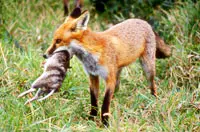
Photo: Red fox with prey
The natural predators of quokkas are birds of prey, goannas, snakes, and introduced animals such as dingoes, foxes, dogs, cats, and feral pigs. Quokkas on the remote offshore islands of Rottnest Island and Bald Island are strictly protected and have no native predators. The primary threat to quokkas on these islands is misplaced human kindness and occasional cruelty. Feeding quokkas "human food" can affect their digestion and make them dependent on human largess.
Why Quokkas Survive on Rottnest & Bald Islands
The Rottnest and Bald islands were separated from the mainland of Australia by the oceans about 6,000 to 8,000 years ago due to a rise in sea level. This was before the arrival of introduced animals such as the dingo, fox, feral pigs, cats and dogs to Australia. Fortunately, these predators could not swim to these islands. Hence the quokka was protected.
Cats were once introduced by European settlers to these islands, but they have since been eradicated.
How the Quokka Almost Became Extinct Who Caused Quokka Near Extinction?
Quokkas have almost been pushed to extinction in recent years. Fossil records show that their range once covered an expanse of 41,000 square kilometres in south-western Western Australia, and they were widespread when the first European settlers arrived in the region in 1829. However, by the 1930s, the quokka population had decreased drastically due to hunting and poisoning by humans. The introduction of the red fox in the 1930s brought about a catastrophic decline in the number of quokkas on the mainland and brought them to near extinction.
Quokka Conservation Status The Quokka is a Vulnerable Species
Quokkas are classified as a vulnerable species, and they will face extinction unless protected. The quokka population is approximately 10,000-12,000 quokkas on Rottnest Island and less than 1,000 in the south-western parts of Western Australia.
You cannot own or keep a quokka as a pet. It is illegal.
How Rottnest Island Got Its Name
Rottnest Island is a 19sq kilometre island off the coast of Western Australia, near the present-day city of Freemantle. In 1658, Samuel Volckertzoon, the captain of the Dutch sailing ship Waeckende noted in his journal that he saw a wild cat resembling a civet cat with browner hair. He was the first European to record the sighting of a quokka. In 1696, Willem de Vlamingh, another Dutch sailor, explored the same island and described the island as overrun with 'rats the size of cats'. He named the island "Rotte nest", meaning rat's nest. This name eventually evolved into the island's present name of Rottnest Island.
25 Quokka Facts
- Quokkas are small hopping marsupials.
- Quokkas are best known for their cute smiley faces.
- Actually,they are not smiling at you. It's just the way their mouths are shaped.
- Quokkas weigh between 2.5- 5 kilos and are 40-54 centimetres in length. They are roughly the size of a large cat.
- There are only about 13,000 quokkas in the wild.
- They are found mainly on Rottnest Island, off the coast of Western Australia.
- And are mostly extinct elsewhere.
- Quokkas prefer moist conditions with dense scrubland.
- They feed on leaves and the soft shoots of woody plants.
- Because of the food sources available on Rottnest Islands, they have adapted to eating succulents and grasses.
- Quokkas eat by biting off a piece of vegetation, stuffing it into their mouths and swallowing it.
- They regurgitate it later, chew it thoroughly and swallow it once more.
- They need very little water to survive.
- Quokkas can climb small trees. Most other macropods can't.
- A baby quokka is called a joey.
- It is smaller than a grain of rice when born.
- It crawls up into its mother's pouch and grows there for six months or so.
- A quokka mother may sometimes discard the baby in her pouch when fleeing a predator.
- Quokkas live for about 10 years.
- The name quokka originated from the native Aboriginal name gwaga or kwaka.
- Quokkas face the threat of extinction.
- It is illegal to touch or feed a quokka.
- Quokkas are quite harmless.
- But have razor-sharp teeth and sharp claws.
- They can bite and scratch if frightened.
All Rights Reserved. (Last Updated: Mar 19, 2024)